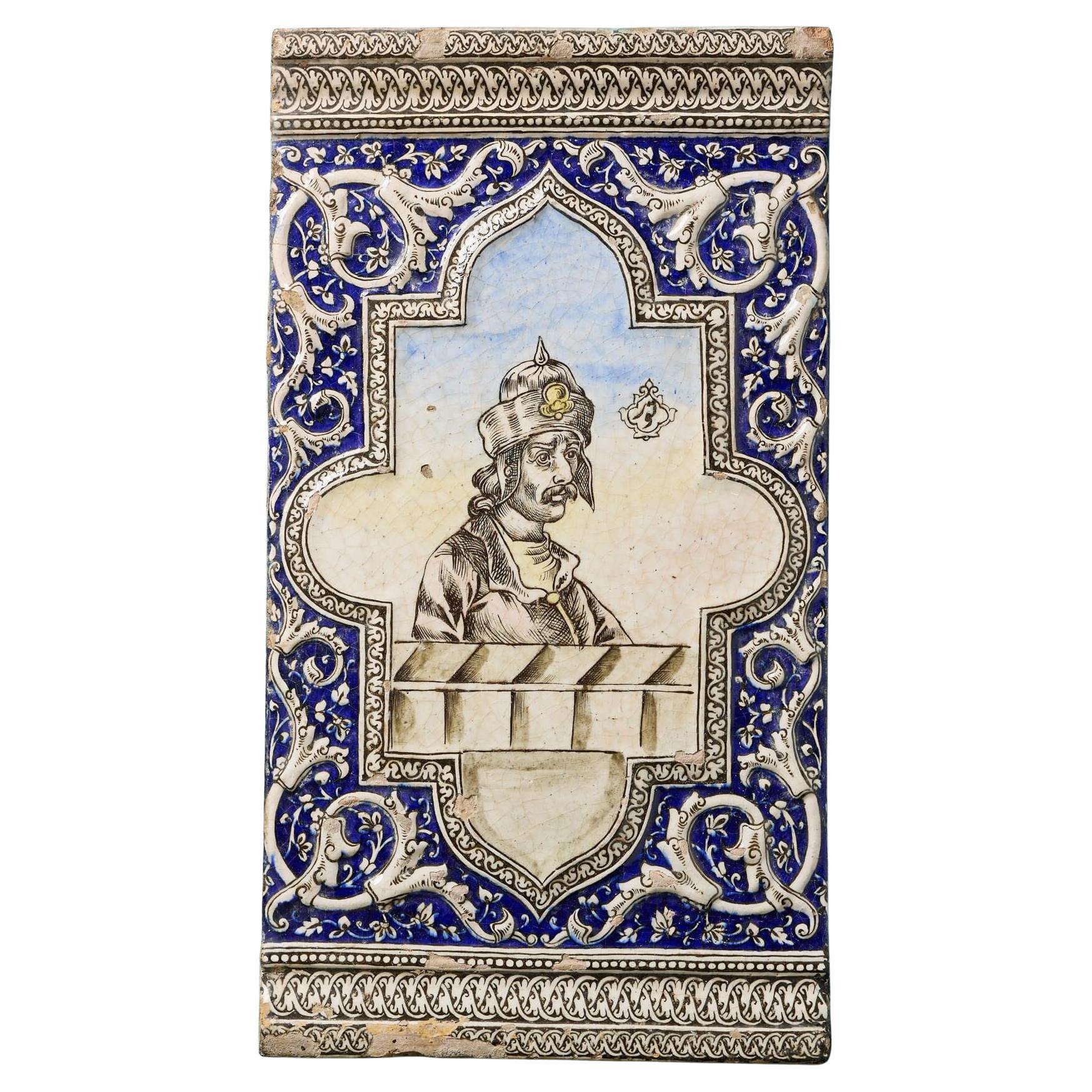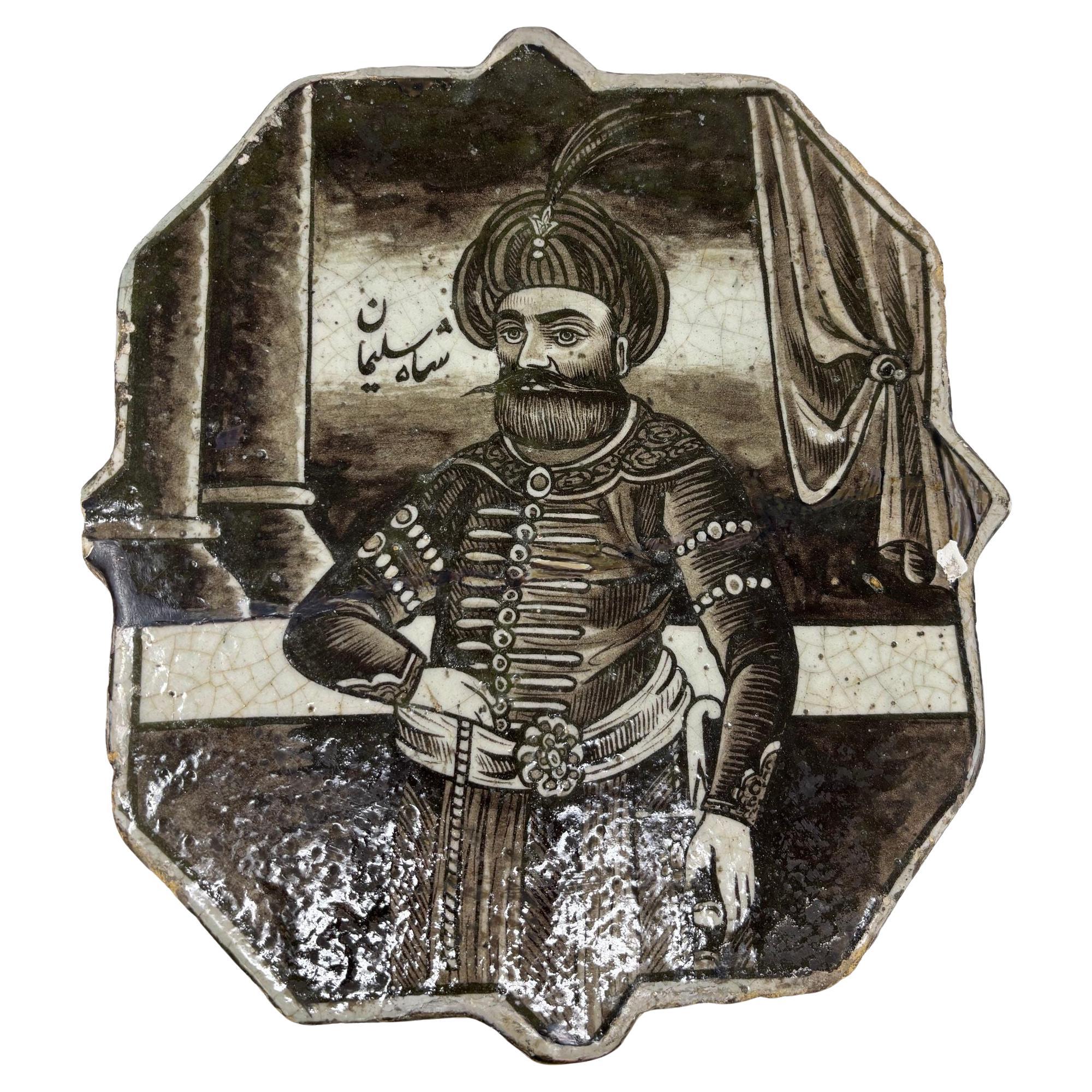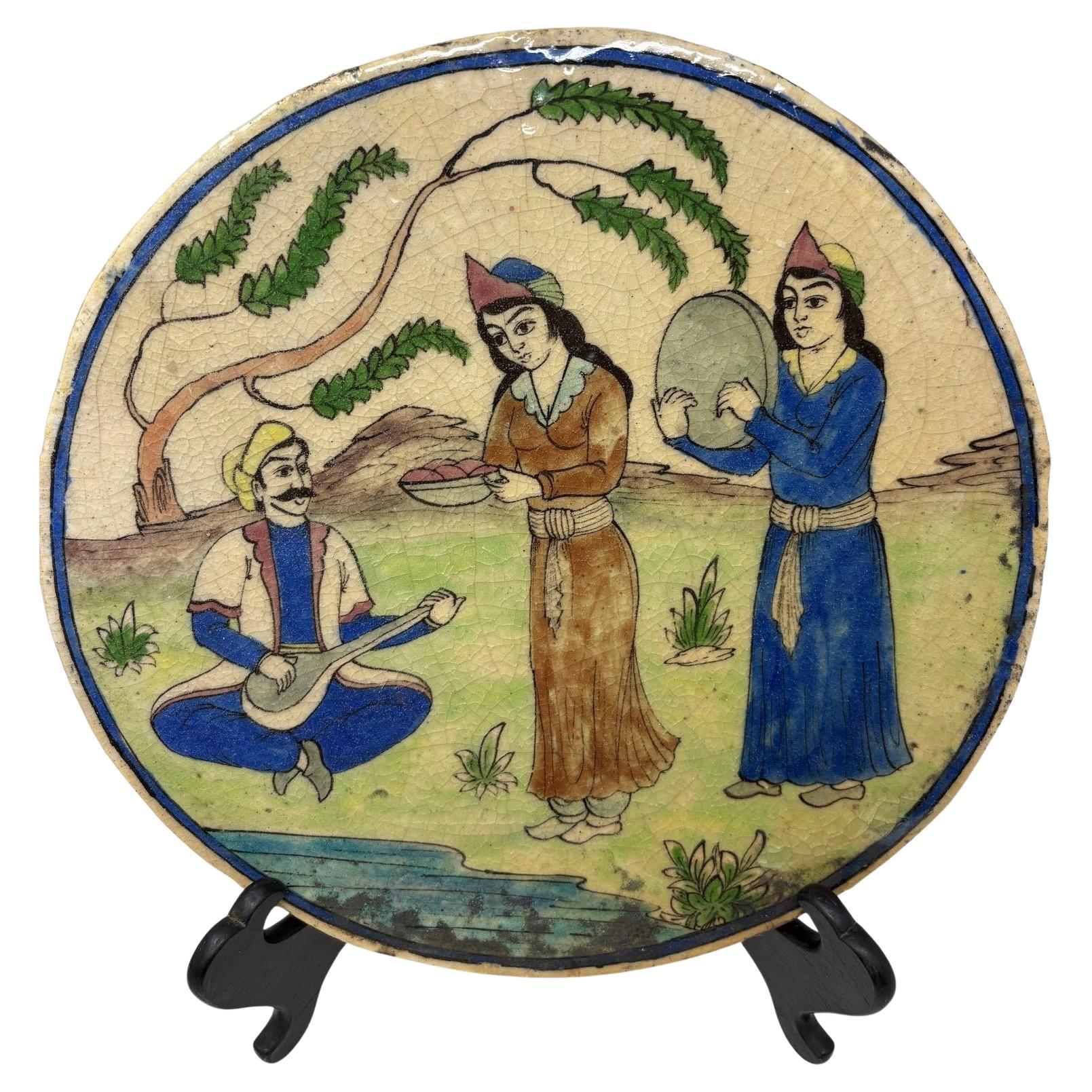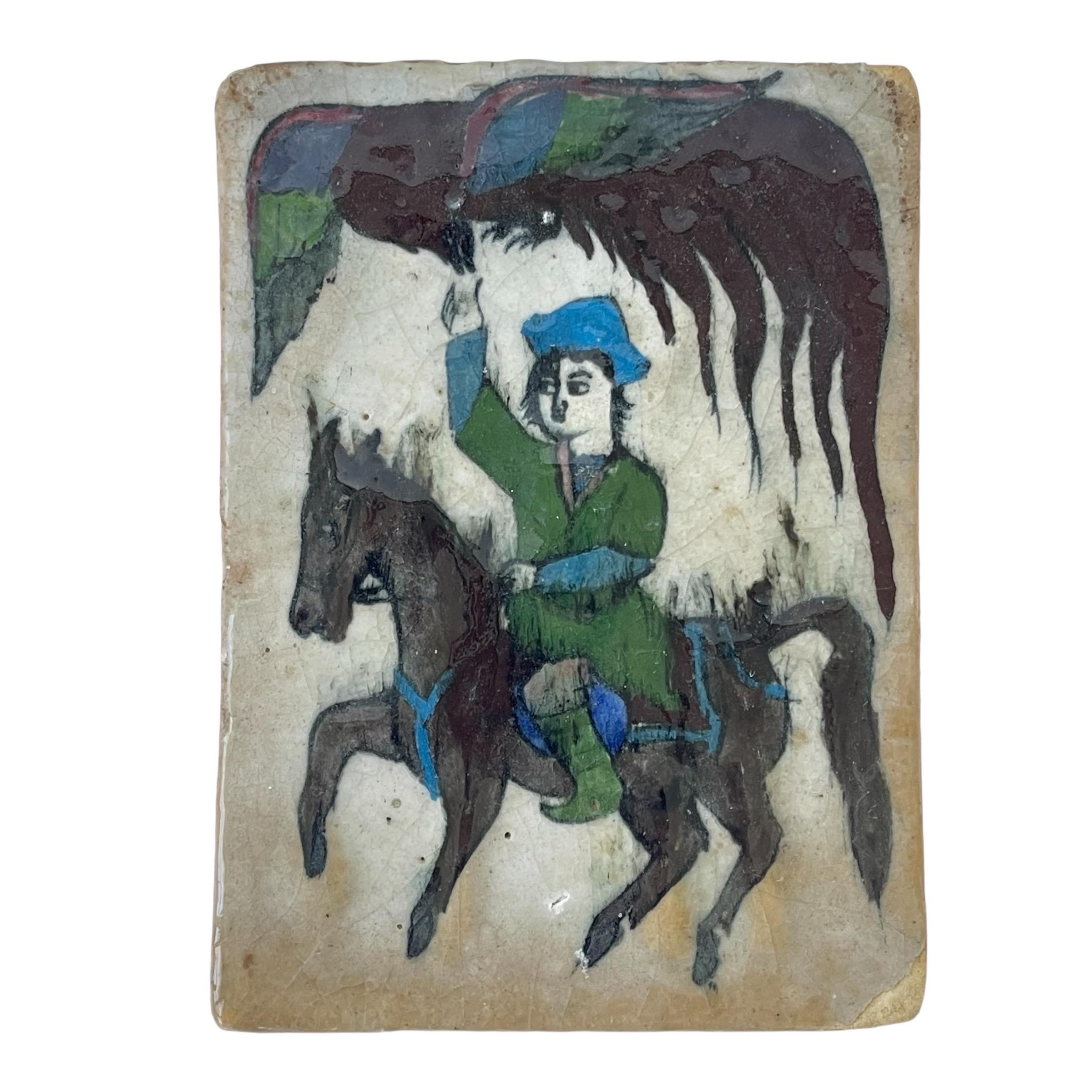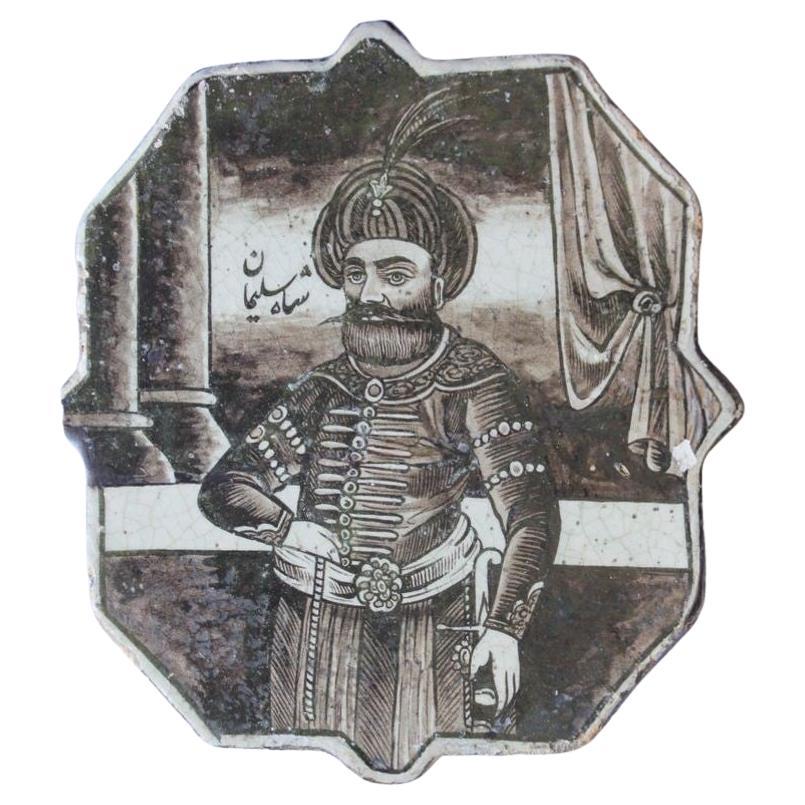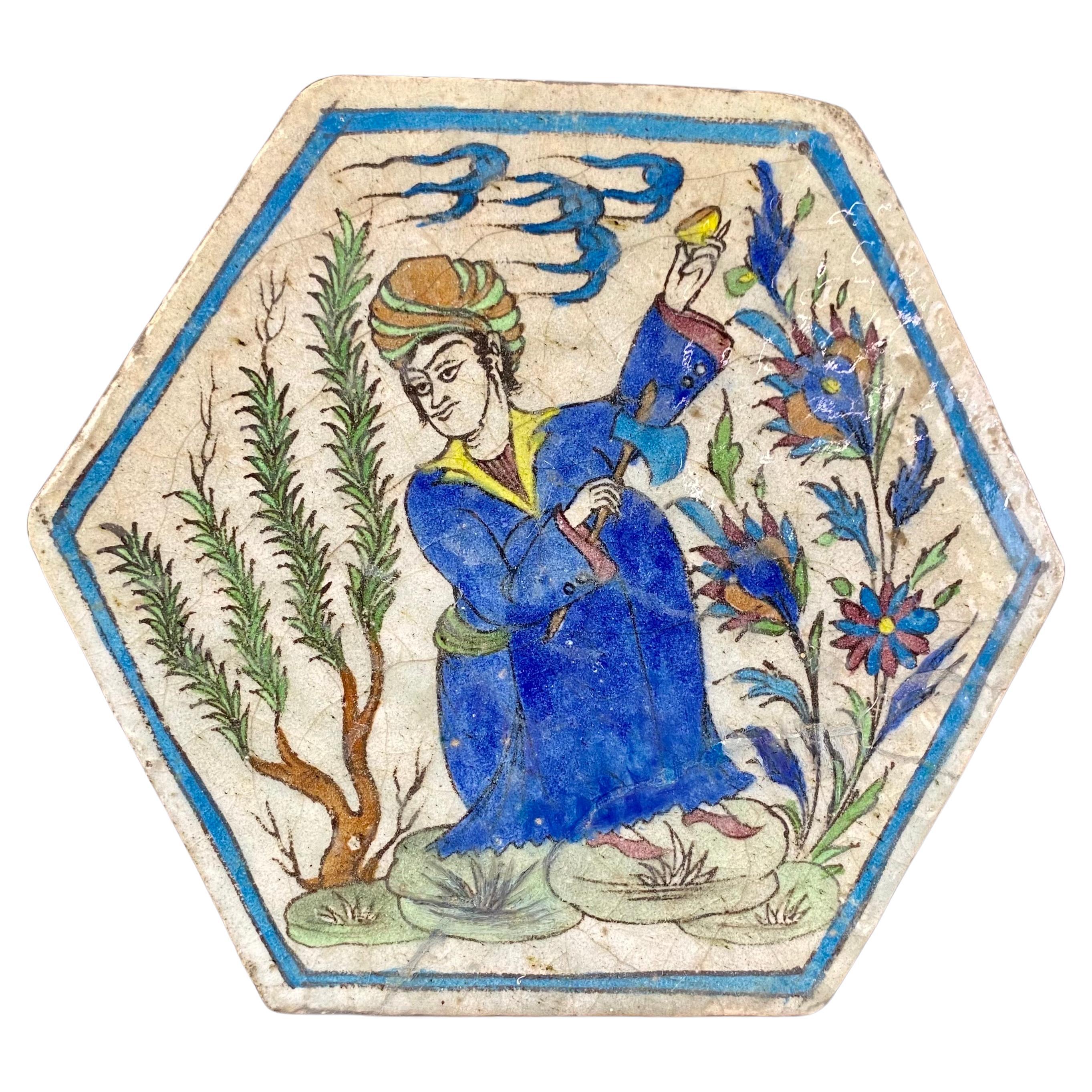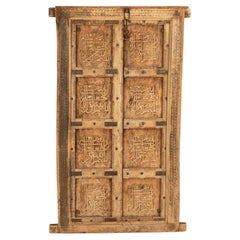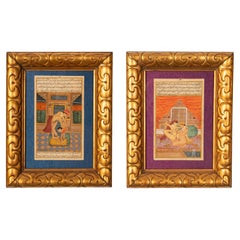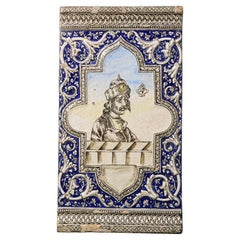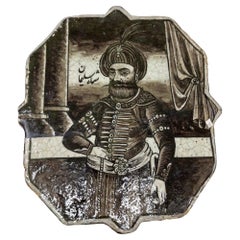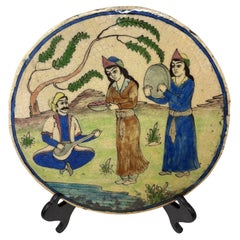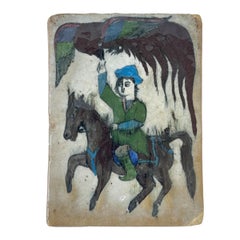Articles similaires à Antique 18th Century Persian Islamic Safavid Cuerda Seca Pottery Tile Rostam
Vous voulez plus d'images ou de vidéos ?
Demander au vendeur plus d'images ou de vidéos
1 sur 13
Antique 18th Century Persian Islamic Safavid Cuerda Seca Pottery Tile Rostam
1 195,24 €
À propos de cet article
Important Antique 18th Century Persian Islamic Safavid Cuerda Seca Pottery Tile depicting the legendary Persian hero Rostam, circa 1700.
The tile shows Rostam kneeling, wearing a tunic and a horned helmet, holding a scepter with deer-head finial, Rostam is kneeling under a garland festooned arch, with a falcon on a perch & a flowering urn. The background of the tile is cobalt blue with a lighter blue to the top & base, the tile is also decorated with hues of mustard, green, brown and pink. The tile is housed in a 19th century japanned wooden frame, condition is very good no damage or restoration, this rare Cuerda Seca tile is ready to hang on your wall.
Rostam or Rustam was a legendary hero in Persian mythology, the son of Zāl and Rudaba, whose life and work was immortalized by the 10th-century Persian poet Ferdowsi in the Shahnameh, or Epic of Kings, which contains pre-Islamic Iranian folklore and history. However, the roots of the narrative date much earlier.
In the Shahnameh, Rostam and his predecessors are Marzbans of Sistan (present-day Iran and Afghanistan). Rostam is best known for his tragic fight with Esfandiyār, the other legendary Iranian hero; for his expedition to Mazandaran (not to be confused with the modern Mazandaran Province). He is also known for the story of his Seven Labours.
Rostam was always represented as the mightiest of Iranian paladins (holy warriors), and the atmosphere of the episodes in which he features is strongly reminiscent of the Parthian Empire.
He rides the legendary stallion Rakhsh and wears a special suit named Babr-e Bayan in battles.
Tile size without frame 8" X 5.50"
- Dimensions:Hauteur : 30,48 cm (12 po)Largeur : 22,86 cm (9 po)Profondeur : 2,54 cm (1 po)
- Style:Islamique (De la période)
- Matériaux et techniques:Poteries,Vernissé
- Lieu d'origine:
- Période:1710-1719
- Date de fabrication:Circa 1700
- État:Usure conforme à l'âge et à l'utilisation. Very good antique condition.
- Adresse du vendeur:Portland, OR
- Numéro de référence:Vendeur : BB-83331stDibs : LU4876145433292
À propos du vendeur
5,0
Vendeur Platine
Vendeurs premium dont la note est supérieure à 4,7 et le délai de réponse de 24 heures maximum
Établi en 2000
Vendeur 1stDibs depuis 2019
422 ventes sur 1stDibs
Temps de réponse habituel : <1 heure
- ExpéditionRecherche du devis...Expédition depuis : Portland, OR
- Politique des retours
Certaines parties de cette page ont été traduites automatiquement. 1stDibs ne garantit pas l'exactitude des traductions. L'anglais est la langue par défaut de ce site web.
Garantie d'authenticité
Bien qu'il soit peu probable que la situation se présente, dans le cas où vous rencontreriez un problème d'authenticité d'un article, contactez-nous dans un délai d'un an pour obtenir un remboursement intégral. DétailsGarantie de remboursement
Si votre article n'est pas conforme à la description, est endommagé pendant le transport ou ne vous est pas livré, contactez-nous sous 7 jours pour obtenir un remboursement intégral. DétailsAnnulation sous 24 heures
Vous disposez d'un délai de 24 heures pour annuler votre achat sans motif.Des vendeurs professionnels agréés
Nos vendeurs de renommée mondiale doivent respecter des normes strictes en matière de service et de qualité, afin de préserver l'intégrité de nos fiches produit.Garantie d'alignement des prix
Si vous constatez qu'un autre vendeur a mis en vente le même article à un prix inférieur sur un autre site, nous nous alignerons sur ce prix.Livraison en toute confiance à l'international
Notre réseau de transporteurs de premier ordre propose des options d'expédition spécialisées dans le monde entier, y compris des livraisons personnalisées.Plus d'articles de ce vendeur
Tout afficherAncienne assiette en poterie Iznik Kutayha Ottomane Islamique du 18ème siècle Turquie 1750
Une bonne assiette ancienne en poterie ottomane Iznik/Kutayha du XVIIIe siècle, vers 1750.
L'assiette a un fond en glaçure crème, peint à la main avec des motifs floraux multicolores...
Catégorie
Antiquités, années 1750, Turc, Islamique, Céramique
Matériaux
Poteries
Ancienne fenêtre de porte arabe du 19ème siècle avec calligraphie islamique marocaine 1850
Une bonne paire de portes ou de volets de fenêtre marocains anciens en bois dur, sculptés avec de la calligraphie islamique, vers 1850.
Les portes sont logées dans leur cadre sculpté...
Catégorie
Antiquités, années 1850, Marocain, Islamique, Portes, portails et barrières
Matériaux
Fer
Antiquités du 18e siècle Paire de peintures miniatures hindoues érotiques Kamasutra 1750
Paire de peintures Kamasutra érotiques indiennes du XVIIIe siècle, vers 1750.
Les peintures, qui proviennent probablement du nord-est de l'Inde ou peut-être du Népal, sont très finem...
Catégorie
Antiquités, Milieu du XVIIIe siècle, Indien, Anglo-indien, Peinture et s...
Matériaux
Peinture
Antique chandelier hispano moresque lustré islamique Mamluk Nasrid 1870
Par The Cantagalli Workshop
Incroyablement rare/unique et monumental chandelier antique en cuivre lustré en poterie islamique Mamluke/Nasrid, vers 1870.
Cet incroyable chandelier en poterie reprend la forme d'...
Catégorie
Antiquités, années 1870, Espagnol, Islamique, Bougeoirs
Matériaux
Céramique
10 648 € Prix de vente
30 % de remise
Tuile ancienne Kütahya Pottery Icon Tile Armenian Virgin Mary & Child Jesus Turkey 1820
Important carreau iconique en poterie Kütahya du XIXe siècle représentant la Vierge Marie et l'Enfant, Turquie vers 1850.
Le carreau a très probablement été fabriqué pour la communau...
Catégorie
Antiquités, Début du XIXe siècle, Turc, Autre, Céramique
Matériaux
Poteries
Ancienne coupe chinoise de la dynastie Qing 1644-1911 en émail sur cuivre, assiette cloisonnée
Très belle coupe creuse en cloisonné de la dynastie chinoise Qing (1644-1911), vers 1880.
Le bol est finement décoré de cloisons en spirale dorées sur un fond d'émail noir. Au centre...
Catégorie
Antiquités, années 1880, Chinois, Qing, Ferronnerie
Matériaux
Cuivre, Émail
Suggestions
Grand carreau islamique en poterie persane Qajar du 19e siècle
Rare grand carreau islamique en poterie persane Qajar du XIXe siècle.
De grande taille, elle est peinte d'une représentation d'un prince perse dans un cartouche de forme flanquée d...
Catégorie
Antiquités, Milieu du XIXe siècle, Perse, Art décoratif
Matériaux
Céramique
Antique carreau de céramique ottomane islamique turque, 1880
Ancien carreau de céramique ottomane turque islamique du 19e siècle, peint à la main.
Figure peinte d'un Shah Suleiman dans un palais devant une colonnade et un rideau.
Écriture arab...
Catégorie
Antiquités, XIXe siècle, Turc, Islamique, Céramique
Matériaux
Céramique, Poteries
Antique carreau décoratif circulaire persan Qajar
Ancienne plaque de tuiles islamiques persanes Qajar du Moyen-Orient du 19e siècle ou avant.
Carreau asiatique mauresque en céramique émaillée représentant une scène d'extérieur avec ...
Catégorie
Antiquités, Fin du XIXe siècle, Asiatique, Islamique, Céramique
Matériaux
Céramique
Ancienne tuile en terre cuite émaillée persane Qajar, faite à la main, Iran, Circa 1900s
Par L’atelier Arman Safavi
Ancien carreau persan Qajar, rendu à la main en céramique argileuse avec une glaçure appliquée à la main présentant une scène d'un fauconnier à cheval, Iran, Circa 1900s
Catégorie
20ième siècle, Perse, Islamique, Éléments architecturaux
Matériaux
Argile, Peinture, Céramique
Antique carreau de céramique ottomane islamique turque
Ancien carreau de céramique ottomane turque islamique du 19e siècle, peint à la main.
Figure peinte d'un Shah Suleiman dans un palais devant une colonnade et un rideau.
Écriture arab...
Catégorie
Vintage, années 1920, Turc, Mauresque, Céramique
Matériaux
Céramique
Tapis hexagonal peint à la main - Période Qadjar Kadjar - Asie
Carreau hexagonal Kadjar en faïence émaillée peint à la main, décoré d'un personnage en habit traditionnel bleu enturbanné d'orange et de vert, tenant une hache et un pot à encens.
F...
Catégorie
20ième siècle, Asiatique, Antiquités
Matériaux
Faïence, Poterie
